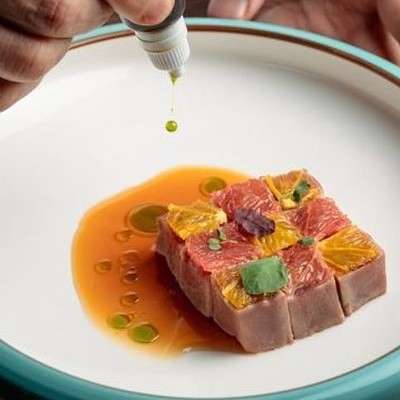This is the 3rd part of a three-part Chef Chat series. If you missed the previous posts, you can read Part 1 here and Part 2 here.
This week, we chatted with Chris Kinjo of MF Sushi, a chef who has worked in countless restaurants, owned a few of his own, achieved fame and glory, and paid the price for it with a staggering financial loss. Now in Houston, he's back behind the sushi bar on a daily basis, doing what he loves at his six-week old restaurant.
And Houston, it's pretty darn spectacular.
Now, before you say that it's all hype, consider this: I myself was skeptical. Sushi is up there with my favorite foods of all time. I went to Peru last year, determined to find sushi comparable to what made Nobu Matsuhisa famous. I visit California regularly, scoping out sushi restaurants. For the first four years I lived in Houston (I first moved here in 1997), I refused to eat sushi, not relenting until I'd found a sushi chef that I could trust (Manabu Horiuchi, formerly of Kubo's, now at Kata Robata). So I can tell you that when I went into MF Sushi, I was prepared to be disappointed.
But then the opposite happened. First, I sat down at the bar, right in front of Kinjo, and took a look at his sushi case. This has always been my litmus test at sushi restaurants. I like to sit at the bar, see with my own eyes how fresh the fish looks, and then ask for recommendations from the chef for the best selections of the day, or let him handle everything omakase style if I'm not in a hurry. And Kinjo's fish case -- every single piece -- looked like fish I would want to order. The colors of the fish were vibrant, none of them having that flat, sometimes grayish tinge that I associate with frozen fish or fish that's being served beyond its prime. Everything looked moist and juicy, and, yes, fresh.
And so, I let the chef do his thing. And his thing turned out to be an 18-course omakase, or chef's tasting, that I haven't stopped talking about or thinking about since that day. I have a photographic memory when it comes to food, but we were served so many different types of sushi that night that I've had to refer back to my photos for some of the unfamiliar fish types that I'd never tasted before.
The highlight of the night for me was the sashimi platter. He served King Salmon, Inada, or baby yellowtail, and kinmedai, or golden eye snapper, classically presented in a colorful arrangement of orange, pinkish-purple, and light pink. Each fish had me in a literal swoon. Each piece had this melt-in-your mouth texture and flavor: the salmon, silky smooth and buttery, the inada, kind of smoky and different in a good way, and the kinmedai had this pleasing suppleness to it, along with a bright cherry-red sliver of skin on it but not the slightest hint of fishiness to it.
We continued with a live scallop, one of my favorites for its sweetness and almost spongy, light texture. Served on the scallop shell with nothing but a small slice of lemon, the scallop was beautifully sweet, the flavor pure. I loved that Kinjo automatically saved the scallop muscle, or engawa, to serve like a hot appetizer. While many waste what can be considered a throwaway piece of the scallop, these slightly crispy innards were thinly sliced and served in a sauté of soy, mirin, sake and butter, tasting a bit like a cross between cartilage and fresh squid, or ika.
Next came a slew of made-to-order sushi, each piece hand-formed and served one at a time, centered on plates of differing shapes and colors: akamutsu was served on a brown earthenware plate; hamachi, or yellowtail, served on a square plate with a round yellow center; hamachi belly on shiny white porcelain; salmon and shima aji, each came on a wooden, red-colored plate with a rim of texture mimicking the fish scales; andaji on a white porcelain.
"I notice the plates are all different colors and shapes; how much thought do you put into the plating of each dish?" I asked.
"I lose sleep over the plating. It's all I think about," Kinjo replied, telling me that he still had a warehouse full of plates he'd brought over from Japan.
We continued with a few dishes you won't see often in Houston. Monkfish liver, considered the foie gras of the sea, was creamy and smooth, topped with a bit of black caviar, followed by a yamakuku appetizer of this strange, glutinous, soupy sauce with chunks of tuna in it that was probably my least favorite course. "It's a very traditional Japanese dish," Kinjo told me, noting my reaction.
What followed was a light cucumber dish, a moro-kyu, or cucumber with red miso, which acted like an intermezzo before he brought out the trifecta of creaminess: chu toro, or mid-fatty tuna; toro, or fatty tuna; and San Diego uni, or sea urchin. Each piece of sushi was utterly delectable -- the rice mildly flavored and almost fall-apart in its formation, and the fish, brushed with a shiny layer of niriki sauce, needing nothing in terms of enhancement. Each piece was a perfect bite, through and through.
We ended with a traditional piece of tamago, or sweet egg, which Kinjo made with a consistency that reminded me of the French flan nature, or natural flan.
Sometimes, when you finish a meal, there is ambivalence. "What did you think?" I asked my dining companion. "It was pretty fantastic," he cautiously replied, his body language telling me that he was kind of stupefied over what we'd experienced. "It reminded me a lot of that movie, Jiro Dreams of Sushi," he remarked.
For me, there was no ambivalence. It was without a doubt one of the best sushi experiences I've had in Houston, and as testament to that fact, I'm going back tonight with a group of friends. We've reserved the sushi counter, and I have no doubt Kinjo will deliver. Because whatever you say or has been said about Kinjo, he can definitely make authentic, old-school, Japanese-style sushi. And I'll happily buy that any day.
Chris Kinjo MF Sushi 5887 Westheimer Road Tel: 832-530-4321 mfsushihouston.com
Follow Eating Our Words on Facebook and on Twitter @EatingOurWords






